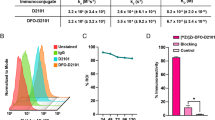Abstract
Intravenously injected haematoporphyrin derivative localizes in malignant tissue more than it does in the surrounding normal tissues; this allows cancer to be treated photodynamically.
The aim of this study is to determine whether adenomas of the large bowel, which are benign precarcinomatous lesions, accumulate HPD as well as does malignant tissue, and whether such accumulation occurs to a greater extent than it does in the surrounding normal mucosa. For this purpose, microspectrofluorometric analysis was performed on biopsy samples of adenomas, on adenocarcinomas, and on normal mucosa, and the data were compared. The samples were obtained from patients affected by histologically proven adenocarcinomas and synchronous adenomas of the bowel 48h after intravenous injection of HPD (3 mg/kg bodyweight), that is, the time interval usually required for photodynamic therapy.
The intensity of fluorescence of the adenomas was a little lower than that observed from adenocarcinomas, but was higher than that from the surrounding mucosa. The fluorescence spectra from adenomas and from adenocarcinomas showed three main emission bands centred at about 630, 670 and 700 nm. The relative amplitudes of the band at 630 and 670 nm in benign and malignant colorectal tumours varied with the excitation wavelength, depending on the different physicochemical state of the accumulated drug. A further analysis, performed 72 h after administration, indicated the existence of an intratissue turnover of the porphyrins.
Similar content being viewed by others
References
Muto T, Bussey HJR, Morson BC. The evolution of cancer of the colon and rectum.Cancer 1981,48:151–60
Fenoglio CM, Pascal RR. Colorectal adenomas and cancer. Pathologic relationships.Cancer 1982,50:2601–8
Jackman RJ, Mayo CW. The adenoma-carcinoma sequence in cancer of the colon.Surg Gynecol Obstet 1951,93:327–30
Morson BC, Dawson IMP.Gastrointestinal pathology, 2nd Edition. Oxford: Blackwell Scientific Publications, 1979:542
Nagy GS, Barratt PJ. Endoscopic polypectomy: an effective cancer prophylactic.Digestion 1977,16:265–6
Gilbertsen VA, Nelms JM. The prevention of invasive cancer of the rectum.Cancer 1978,41:1137–9
Sugarbaker PH, Gunderson LL, Wittes RE. Colorectal cancer. In: De Vita V, Hellman S, Rosenberg SA (eds)Cancer, principle and practice of oncology, 2nd Edition. Philadelphia: Lippincott, 1985:795–884
Wheat MW, Ackerman LV. Villous adenomas of the large intestine. Clinicopathologic evaluation of 50 cases of villous adenomas with emphasis on treatment.Am Surg 1958,147:476–87
Dougherty TJ, Kaufman JE, Goldfarb A et al. Photoradiation therapy for the treatment of malignant tumors.Cancer Res 1978,38:2628–31
Gomer CJ, Dougherty TJ. Determination of3H- and14C-hematoporphyrin derivative distribution in malignant and normal tissue.Cancer Res 1979,39:146–51
Spinelli P, Dal Fante M. Photodynamic therapy in the digestive tract: an international enquiry. In: Waidelich W, Kiefhaber P (eds)Proceedings of the 7th international congress on laser optoelectronics in medicine. Springer-Verlag, 1986:450–7
Dahlman A, Wile AG, Burn RC et al. Laser photoradiation therapy of cancer.Cancer Res 1983,43:430–4
Freitas I, Giordano P, Bottiroli G. Improvement in microscope photometry by voltage to frequency conversion: analogue measurement and digital processing.J Microscopy 1981,124:211–8
Bottiroli G, Ramponi R. Equilibrium among hematoporphyrin derivative components: influence of the interaction with cellular structures.Photochem Photobiol 1988,47:209–14
Watt AG, House AK. Colonic carcinoma. A quantitative assessment of lymphocyte infiltration at the periphery of colonic tumors related to prognosis.Cancer 1978,41:279–82
Nash JRG. Macrophages in human tumors: an immuno-histochemical study.J Pathology 1982,136:73–83
Pretlow TP, Boohaker EA, Pitts AM et al. Heterogeneity and subcompartmentalization in the distribution of eosinophils in human colonic carcinomas.Am J Pathol 1984,116:207–13
Saffos RO, Rhatigan RM. Benign (non-polypoid) mucosal changes adjacent to carcinomas of the colon. A light microscopic study of 20 cases.Human Pathol 1977,8:441–9
Cubeddu R, Ramponi R, Bottiroli G. Time-resolved fluorescence spectroscopy of hematoporphyrin derivative in micelles.Chem Phys Lett 1986,128:439–42
Cubeddu R, Ramponi R, Bottiroli G. Disaggregation effects on hematoporphyrin derivative in the presence of surfactants at different concentration: temperature dependence. Proceedings of the European Conference on Optics, Optical Systems and Applications.Proc SPIE 1987,701:316–9
Sauer K, Smith JRL, Schultz AJ. The dimerization of chlorophylla, chlorophyllb and bacteriochlorophyll in solution.J Am Chem Soc 1966,88:2681–8
Bottiroli G, Ramponi R, Croce AC. Quantitative analysis of intracellular behaviour of porphyrin.Photochem Photobiol 1987,46:663–8
Moan J, Christensen T, Somer S. The main photosensitizing component of hematoporphyrin derivative.Cancer Lett 1982,15:161–6
Dougherty TJ. Photodynamic therapy. In: Kessel D (ed)Methods in porphyrin photosensitization. New York: Plenum, 1985:313–28
Redmond RW, Land EJ, Truscott TG. Aggregation affects on the photophysical properties of porphyrins in relation to mechanism involved in photodynamic therapy. In: Kessel D (ed)Methods in porphyrin photosensitization. New York: Plenum, 1985:293–302
Kessel D. Proposed structure of the tumor localizing fraction of HPD (hematoporphyrin derivative).Photochem Photobiol 1986,44:193–6
Spinelli P, Dal Fante M, Meroni E. Endoscopic lasertherapy of colorectal tumors.Acta Endosc 1987,17:157–68
Brunetaud JM, Mosquet L, Houcke M et al. Villous adenomas of the rectum. Results of endoscopic treatment with argon and Nd-YAG lasers.Gastroenterol 1985,89:832–7
Mathus-Vliegen EMH, Tytgat GNJ. Nd-YAG laser photocoagulation in colorectal adenoma. Evaluation of its safety, usefulness, and efficacy.Gastroenterol 1986,90:1865–73
Author information
Authors and Affiliations
Rights and permissions
About this article
Cite this article
Dal Fante, M., Bottiroli, G. & Spinelli, P. Behaviour of haematoporphyrin derivative in adenomas and adenocarcinomas of the colon: a microfluorometric study. Laser Med Sci 3, 165–171 (1988). https://doi.org/10.1007/BF02593808
Received:
Issue Date:
DOI: https://doi.org/10.1007/BF02593808




